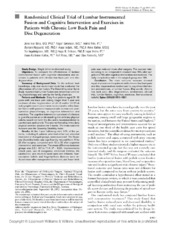Randomized clinical trial of lumbar instrumented fusion and cognitive intervention and exercises in patients with chronic low back pain and disc degeneration
Brox, Jens Ivar; Sørensen, Roger; Friis, Astrid; Nygård, Øystein; Indahl, Aage; Keller, Anne; Ingebrigtsen, Tor; Eriksen, Hege Randi; Holm, Inger; Koller, Anne Kathrine; Riise, Rolf; Reikerås, Olav
Peer reviewed, Journal article
Published version
Permanent lenke
https://hdl.handle.net/1956/1929Utgivelsesdato
2003Metadata
Vis full innførselSamlinger
Originalversjon
https://doi.org/10.1097/01.brs.0000083234.62751.7aSammendrag
Study Design: Single blind randomized study. Objectives: To compare the effectiveness of lumbar instrumented fusion with cognitive intervention and exercises in patients with chronic low back pain and disc degeneration. Summary of Background Data: To the authors’ best knowledge, only one randomized study has evaluated the effectiveness of lumbar fusion. The Swedish Lumbar Spine Study reported that lumbar fusion was better than continuing physiotherapy and care by the family physician. Patients and Methods: Sixty-four patients aged 25–60 years with low back pain lasting longer than 1 year and evidence of disc degeneration at L4–L5 and/or L5–S1 at radiographic examination were randomized to either lumbar fusion with posterior transpedicular screws and postoperative physiotherapy, or cognitive intervention and exercises. The cognitive intervention consisted of a lecture to give the patient an understanding that ordinary physical activity would not harm the disc and a recommendation to use the back and bend it. This was reinforced by three daily physical exercise sessions for 3 weeks. The main outcome measure was the Oswestry Disability Index. Results: At the 1-year follow-up visit, 97% of the patients, including 6 patients who had either not attended treatment or changed groups, were examined. The Oswestry Disability Index was significantly reduced from 41 to 26 after surgery, compared with 42 to 30 after cognitive intervention and exercises. The mean difference between groups was 2.3 (-6.7 to 11.4) (P = 0.33). Improvements inback pain, use of analgesics, emotional distress, life satisfaction, and return to work were not different. Fearavoidance beliefs and fingertip-floor distance were reduced more after nonoperative treatment, and lower limbpain was reduced more after surgery. The success rateaccording to an independent observer was 70% after surgery and 76% after cognitive intervention and exercises. The early complication rate in the surgical group was 18%. Conclusion: The main outcome measure showed equal improvement in patients with chronic low back pain and disc degeneration randomized to cognitive intervention and exercises, or lumbar fusion.
Beskrivelse
Reproduced with permission from the publisher
